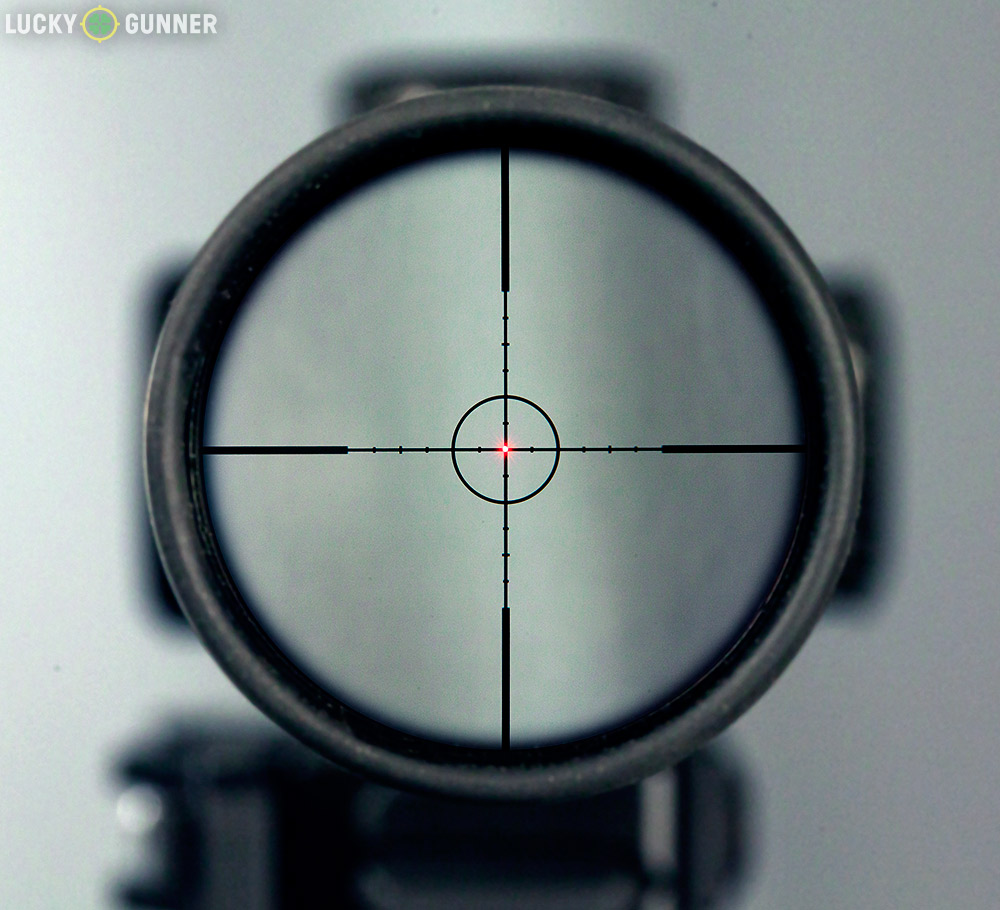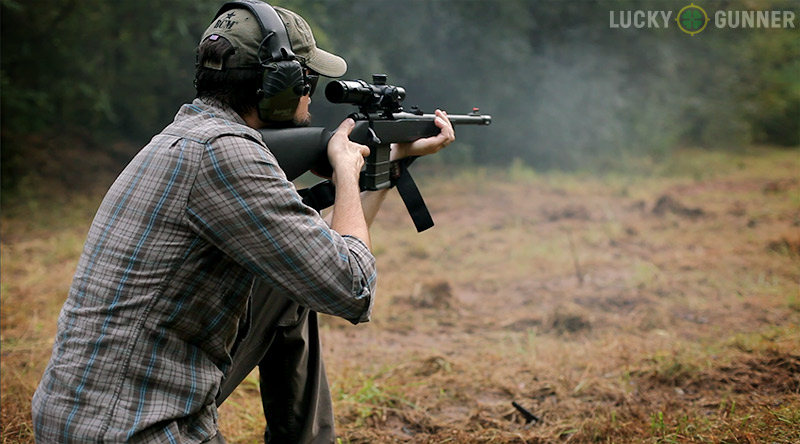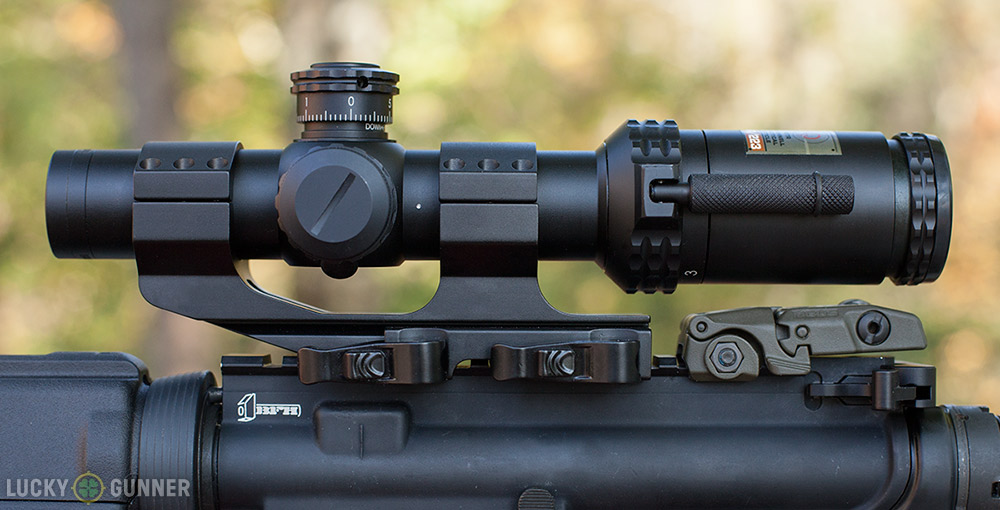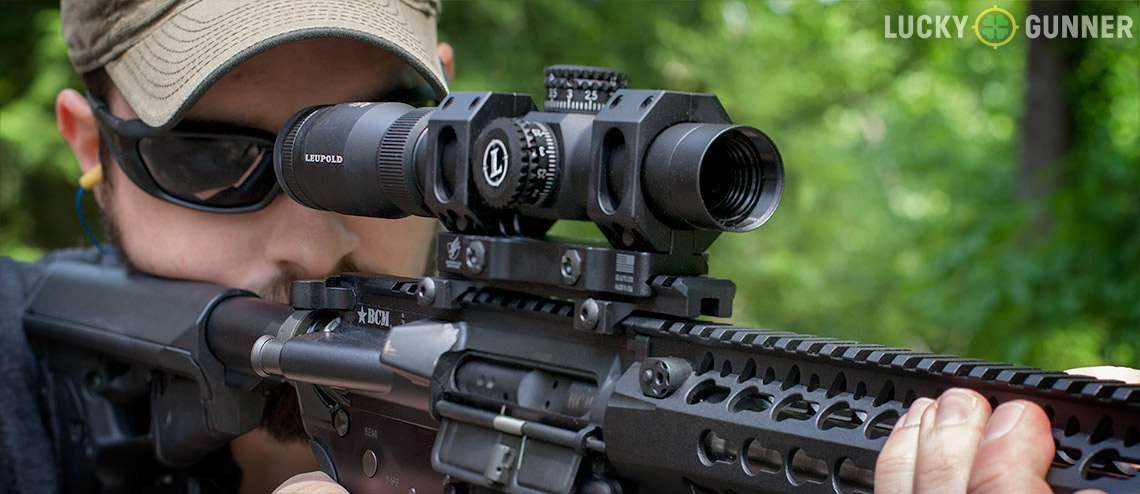I’ve noticed that a lot of less experienced shooters tend to buy more magnification than they need when they’re looking for a rifle scope. I certainly felt that temptation when I went shopping for my first scoped rifle.
High magnification scopes don’t necessarily have high price tags, so when you see that a manufacturer has a really nice 1-4x optic, but they also offer a big 4-12x that’s in your price range, those larger numbers are alluring. High magnification helps you see the target better, which doesn’t seem like it could be a bad thing. But these scopes do come with drawbacks.
There’s a time and place for higher magnification, but, for most practical purposes, a low power scope is adequate and comes with some benefits that are easy to overlook. Fortunately, we’re living in a golden age for low power scopes. The growing world of 3-gun competition has created a new market for low power scopes, and they’ve been popular with military and law enforcement for years. Even the hunting community is getting on board with hog hunters looking for scopes that can be used on close range moving targets. Here are a few of the reasons for the rising popularity of the compact low magnification variable power optics that can give shooters an edge that bigger scopes don’t.
Close Range Speed
The major appeal of lower power variable optics is the low-end magnification. Today, there’s a huge assortment of scopes on the market with a low-end in the 1x to 2x range. Dialed down to the lowest possible magnification, these scopes are perfect for engaging close range targets. Hunters, military, law enforcement, and civilians arming for home defense all have to plan for the possibility of targets that could suddenly appear from anywhere. Too much magnification at close range means it’ll take a few seconds to find the target through the scope. With a low magnification scope, the shooter can simply bring the rifle to eye level and fire.

Recently, optics sporting a “true” 1x (no magnification) low end are all the rage. These are optics that cause zero optical distortion on their lowest setting for maximum speed in target acquisition. This is a nice feature to have, but can add a lot of expense to a variable power scope. A scope with 1.25x or even 1.5x low-end magnification is still very usable even on targets just a few yards away. For hunters looking for a little more magnification than the typical 1-4x scopes, even a 2-7x scope can provide a better chance at a shot on a moving animal inside 25 yards than the more ubiquitous 3-9x optics.
Medium Range Stability
I won’t try to argue that low power scopes are better at long range, but they can be a huge benefit at medium range. Of course, the whole long/medium/close range thing is a bit subjective. For our purposes, let’s say “long range” is the distance where you can no longer confidently hit a target unless you’re shooting from a prone position, shooting bench, or some other supported rest. And we’ll consider targets inside 50 yards to be close range and medium range is everything in between.

This in-between range is where low power scopes are really handy. You might want a little magnification, but not a ton. When shooting from a field position like standing, kneeling, or sitting, too much magnification can actually be a hindrance because of what’s sometimes called the “wobble zone”. Unless you’re shooting from a rest, there’s going to be some amount of movement in the scope. At lower magnification, the wobble will appear to be manageable, and with good technique, it can be minimized. But crank up the magnification on a higher power scope and the same target at the same distance will look like it’s moving all over the place, even with correct technique. Anyone who’s looked through a pair of binoculars at an object too close has experienced this phenomenon — it’s disorienting and the magnification actually makes it more difficult to see the subject clearly.
Fortunately, most variable high magnification scopes these days have a low-end magnification that’s still pretty usable at medium distances. But, with a low power scope, there’s less temptation to crank up the magnification to a level that’s less than helpful.
Low Profile
Size and weight are other big advantages that low power scopes bring to the table. The small objective lens (the end of the scope closer to the target) of the low power scopes allows them to be mounted very low to the rifle, which many shooters find helpful in maintaining a consistent position on the stock from shot to shot. Smaller scopes also make the rifle easier to carry and are less likely to get in the way when you’re doing anything other than actually shooting them.

For a lot of shooters, weight isn’t a major priority, but I prefer to keep my rifles light whenever possible. The current trend in the low power scopes market is to beef up the high end of the magnification range, so we’re now seeing more 1-6x, and even 1-8x scopes. Unfortunately, that increase in magnification range also usually comes with a big increase in weight. But some scope manufacturers are still making low power optics that add minimal heft to the rifle. Leupold, in particular, offers several low profile optics that weigh less than a pound, including the mount. I’ve recently been trying out their 11.5 ounce VX-R Patrol 1.25-4x20mm on my AR. It’s not as handy as the non-magnified Aimpoint Micro red dot I previously had mounted, but the Leupold still allows the rifle to maintain a quick-handling balance.
You Can’t Buy Skill
Higher magnification doesn’t make a bad shooter better and usually won’t even help them become better. In reality, bad technique is only made worse when using high magnification. This is why so many experienced shooters advocate for novices to always learn to master iron sights first before trying optics. Personally, I’m not convinced that iron sights should be a mandatory prerequisite for everyone, but I do think that most shooters who opt to scope their first rifle will benefit more from a low power scope.
Learning the fundamentals of marksmanship usually will involve targets at 100 yards or less, and a 1-4x scope is plenty adequate to shoot some decent groups at those ranges.

Clarity, Not Magnification
I’ve talked to several shooters who have gone the low power optic route but then become frustrated with not being able to see targets clearly at 100 or 200 yards. The obvious solution is to buy another scope with higher magnification, but I think more often the problem is cheap scopes. You can get a lot more scope for your money today than in the past, but a $100 scope is still a $100 scope, and it’s going to have some limitations. The first thing to be sacrificed in a low-end scope is usually the image quality.
If you like the small form factor and speed of low power scopes but find yourself wanting more visibility at extended ranges, consider an upgrade in quality instead of magnification. Spending a little more on a scope can sometimes go a long way in terms of optical clarity. However, beware of diminishing returns — a $700 scope might be 10 times better than a $100 scope, but a $1500 model may only offer marginally greater sharpness than the $700 model, and it might only be apparent in dimmer lighting conditions.
Low Power Scope Recommendations

There are dozens of excellent options on the market for variable low power optics, ranging in price from less than $100 to well over $2500. Here’s just a handful of the mid-priced options that have earned a solid reputation:
Bushnell 1-4x24mm Thrown Down PCL
I covered this one in our Bushnell scopes mini-review a few months back. At 17.3 ounces, it’s a bit heavy for my liking, but it packs a lot of features into a very attractive price tag like first focal plane, illuminated BDC reticle, and a “throw down” lever for rapid power change. This is a nice option for a budget 3-gun setup.
MSRP: $387
Leupold VX-R Patrol 1.25-4x20mm
I mentioned this one above, but it’s good enough to deserve another plug. The VX-R Patrol is awesome — it’s light, the image is clear, and the illuminated “fire dot” reticle is visible even in bright daylight. If you like to keep weight off your rifle like me, this might be one of the best low power optics on the market under $1000.
MSRP: $749.99
Leupold Mark AR MOD 1 1.5-4x20mm
If the light weight of the VX-R patrol is appealing but the price is still a little out of your budget, then the Leupold Mark AR is the one you want. I haven’t looked at the two side by side, so I don’t know how the image quality compares, except that the low-end on the Mark AR only goes down to 1.5x rather than the 1.25x of the VX-R. Even so, this optic seems to have a lot of very satisfied fans, and is worth considering.
MSRP: $564.99 (illuminated), $374.99 (non-illuminated)
Burris MTAC 1-4x24mm
This is another one that’s popular with the 3-gun crowd. It features an illuminated reticle with a unique design involving BDC dots surrounded by a thick ring. Not everybody’s cup of tea, but some people find it to be quick and easy to use.
MSRP: $479
Vortex Viper PST 1-4x24mm
The upcoming Vortex Strike Eagle 1-6×24 scope has recently overshadowed the tried and true Viper PST, but the older 1-4x may still be worth considering. For starters, it’s one of the only low power scopes available with an MRAD reticle, which is a huge selling point for shooters who want to stick with a MIL-based reticle on all their optics. The Viper series also has a reputation for ruggedness and excellent image clarity in this price range. I’ve gotten a lot of good mileage out of my 2.5-10×44 Viper PST, and by all indications the 1-4x version offers the same great value. Available with MOA or MRAD reticle (both illuminated), capped or uncapped turrets.
MSRP: $599


I’ve got that bushnell; it’s been pretty good but I haven’t exactly stretched it’s legs. I know folks talk about knowing how to shoot with iron sights but frankly my vision is horrible and scopes really help. I keep it at 4x and it’s good for 50-100 yards for me. Might could go to 150 or so, but I haven’t tried yet.
My young eyes were good to 125 yards or more so a good 4x scope should work out to 400 yards in good light. Even with old eyes a 4x scope works out to 300 yards just fine.
My old eyes work a small Leupold 4X “Shotgun” fixed scope on a Ruger Gunsite Scout .308. Mounted traditionally (not forward) it’s a great setup for me from 30 yards out to about 250. Haven’t tried further.
Just to clarify, the author incorrectly stated that the ocular lens is the one closest to the target. That would be the objective lens. Ocular lens is closest to your eye.
I have the same cz 527 in 7.62×39. I have been looking at a Aimpoint H-2 micro or the leupold vx-r 1.25-4x scope. I am looking at using the rifle for hunting in the woods and as a mini-scout. Non of my shots will be beyond 150 yrds. Which in your opinion is the best suited optic for this rifle?
Thanks